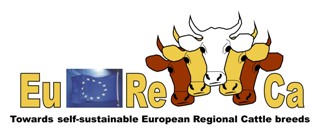WP7
Dissemination and communication
WP7 will focus only on the appropriate dissemination of results of all work packages.
Results of WP1, WP2, WP3, WP4, WP5 will be disseminated by each work package through the
project website, publications or contributions to workshops or conferences. The major
output of this project however will be the results of WP6, which is a synthesis of results of
previous work packages in a report or publication, which will be distributed in hard copies and
electronically. The final outcome of the project will also be disseminated in a two-day project
conference, with the objective to attract as many potential users as possible.

Which policies and strategies are required to successfully maintain our European Farm Animal Genetic Resources?
The aim of the EU co-funded EuReCa project was to better understand the state of the local cattle breeds in Europe,
to identify factors that contribute to their success or failure, and to recommend decision-making tools for development
of ambitious and sound strategies and policies. With this publication "Local cattle breeds in Europe: Development of policies
and strategies for self-sustaining breeds" we share the methodology and give a comprehensive view on the local cattle breeds in Europe.
Download pdf (5MB)
Workshop
 |
Local Cattle Breeds in Europe
Towards policies and strategies for self-sustaining breeds
|
 |
Which policies and strategies are required to successfully maintain our European Farm Animal Genetic Resources? The European local cattle populations
were a target in the EURECA project, co-funded by the European Commission (EU AGRI GENRES 870/04).
The general aim was to better understand the state of the breeds, to identify factors that contribute to their success or failure,
and to recommend decision-making tools for development of ambitious and sound strategies and policies.
With this publication "Local cattle breeds in Europe: Development of policies and strategies for self-sustaining breeds" we share the methodology
and give a comprehensive view on the local cattle breeds in Europe.
The majority of cattle breeds in Europe are native or local breeds, usually characterised by a limited geographical distribution.
The breeds have significant potential as they are carrying large amounts of genetic variation and have important cultural, historical,
socio-economic and environmental values. "
Local cattle is living inheritance, old germ plasm which shouldn’t get lost", said one farmer.
Another farmer: "
My cows are like diesel cars; slow start, cheap energy and long life".
These local cattle breeds were once regionally the most popular ones, now many of them are 'at risk'. Hence, there is a need to
(further) develop effective policies and strategies at national and European level to conserve and develop local cattle breeds and
to promote their branded use. The results of the EURECA project were presented at the EURECA-GLOBALDIV conference 5-6 May 2010, FAO, Rome.
Our findings and recommendations will hopefully contribute to the development of successful future strategies for local cattle breeds in Europe.
Presentations
- Assessment of
self-sustainability of local cattle breeds based on farmer interviews and
stakeholder perceptions: similarities and differences between breed cases
(EURECA)
(Gustavo Gandini, UNIMI, IT and Kateriina Soini, MTT, FI).
- Optimal strategies and tools
for management of genetic variation (EURECA) (Asko Mäki-Tanila, MTT, FI
and Miguel Toro, UPM, ES).
- Introduction and presentation
of the EURECA project (Sipke J. Hiemstra, CGN WUR, NL).
- Decision support tools for
breed strategy development (EURECA) (Daniel Martin, INIA, ES, Yvette de
Haas, CGN WUR, NL and Clara Diaz, INIA, ES).
- Role and state of
cryopreservation programs to support local cattle breed conservation
(EURECA) (Flavia Pizzi, IBBA CNR, IT and Delphine Duclos, IE, FR).
Livestock Biodiversity Workshop, FAO, Rome, May 5-6, 2010
Presentations
List of publications





